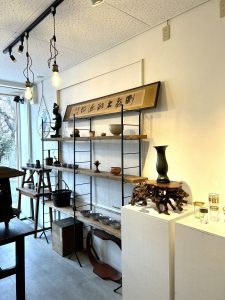真・行・草の流儀とは(愛知県名古屋市千種区姫池通 骨董買取 古美術風光舎)
2024.01.24
皆さまこんにちは。スタッフHでございます。
名古屋では今朝から雪がちらついております。お出かけの方はくれぐれもお気をつけください。
私もできる限りの厚着をして出ました。雪国の方には笑われるかもしれませんが、思わず息を止めてしまうほどの冷たい空気です。
さて本日は前回のブログで綴った煌びやかなグラスたちの横で、渋く鈍い光を放つ古銅花入を眺めております。耳や装飾がなく形の美しさが際立ちます。

古銅花入れは中国から輸入された唐物で高価なものでした。鎌倉時代に禅僧等によりもたらされたものが仏前供花に用いられ、室町初期には将軍家や禅寺などの床の間を飾っていたと思われます。古くは酒器として用いられた青銅器を後世に写して花入れとしたといわれています。銅を主体にして錫・鉛を含む合金で作られ、唐金(からかね)とも呼ばれているそうです。
古銅花入には様々な形がありますが、全体の姿の呼び名は「槌」「中蕪」「下蕪」「蕪無」「薄端」「角木」「月」「舟」「鶴首」…と多くの種類があります。更に「口」の造りや「耳」の形にも様々あるとされています。
室町時代には花生けの中でも主役となり、室町将軍家や大名などの座敷で価値のあるものとして飾られました。
また戦国時代には茶席を飾る花入れや香炉の中で最も格式高いものとして珍重されたとか。戦国大名たちは権威を象徴するもののひとつとして、茶道具など唐物を手に入れたと考えられます。南蛮貿易や中国との貿易で新しいものや珍しいものを手に入れることは大名としての地位の高さを意味しました。
千利休は唐物の花入に花を入れず花入だけを見せる目的で、水をいっぱいに入れて床の間に飾ったとのことです。
古銅花入は茶道において「真・行・草」の中の「真」の花入とされています。材質によりに分けられ、「真」は古銅、唐物青磁。「行」は釉薬のかかった和物の陶磁器。「草」は竹、籠、瓢、釉薬をつけていない陶磁器などとなります。茶事や掛軸、他の道具との取り合わせなどにより使用する花器が選ばれました。
「真・行・草」。なんとなく聞いたことはあるのですが、いつものことながら曖昧な知識ですので調べました。
真・行・草は書道で使われる三つの筆法からきています。楷書のことを真書と呼び、崩した行書、さらに崩した草書の三つ筆法を意味します。これが転じて茶道・華道・俳諧・庭園などにも、この真・行・草の構成が見られ、建築様式のなかでも特に和室の格式の表現形式として用いられています。
一般的に「真」とは厳格に完備したもので、やや砕けて柔らかな形式になったものを「行」、さらに省略されたものを「草」といい、茶室でいうと書院風の茶室は真で、千利休が広めた草庵茶室は草といえます。
しかし格式を表現してはいますが、正統な様式から流麗な様式へと変化する中で明確な区別があるわけではなく、草庵を完成させた利休は「真を知り、行・草に至れば(作法や形態は)いかほど自由にくずそうと、その本性(質)はたがわぬ」と弟子に説いたといわれています。基本となる「真」を知り習得し、それを元に本質を理解することが大切だという意味です。
格式は堅苦しいものに思えますが、外国から取り入れたものや、日本古来の伝統的な技術など「真」となるものを模倣し、崩し、自分なりにアレンジしていくのは日本人が得意とするところで、日本文化の面白さかもしれませんね。
それでは、またお会いしましょう。

Hello everyone. This is Staff H.
It has been snowing in Nagoya since this morning. Please be careful when you go out.
I also put on as much heavy clothing as I could. Those who live in snowy areas may laugh at me, but the air is so cold that it makes me hold my breath.
Today, I am looking at an old copper vase that emits an austere, dull light next to the sparkling glasses I wrote about in my last blog. The beauty of the shape of the vase stands out without ears or decorations.
Old copper vases were imported from China and were expensive. Brought by Zen monks and others during the Kamakura period (1185-1333), they were used for flower offerings before the Buddha, and in the early Muromachi period (1333-1573), they were probably used to decorate the alcoves of the shogun’s household and Zen temples. It is said that bronze vessels used in ancient times as drinking vessels were copied in later times and used as flower vases. It is said to have been made of an alloy containing mainly copper, tin and lead, and is also called karakane (Chinese gold).
There are various shapes of old copper vases, and the overall appearance of the vase is called by many names, such as “tsuchi,” “nakabura,” “shimokabura,” “kaburanashi,” “usubata,” “kakunoki,” “geki,” “fune,” “tsurukubi,” etc. In addition, there are many different types of vases, such as those with a “mouth” or “ear. There are also various shapes of the “mouth” and “ears.
In the Muromachi period (1336-1573), it played a leading role among flower vases, and was displayed as a valuable item in the rooms of the Muromachi shoguns and feudal lords.
In the Warring States period, they were prized as the most prestigious flower vases and incense burners decorating tea rooms. It is thought that warring feudal lords acquired karamono, such as tea ceremony utensils, as a symbol of their authority. Acquiring new and rare items through trade with the Nanban and China meant high status as a feudal lord.
Sen no Rikyu did not put flowers in a karamono vase, but instead filled it full of water and displayed it in his alcove for the purpose of showing only the vase.
In the tea ceremony, the ancient copper vase is considered the “true” vase among the three types of flower vases: “true,” “action,” and “grass. The “true” type is made of old copper and Chinese celadon, while the “go” type is made of glazed porcelain. Gyo” is glazed Japanese ceramics. Sou” is bamboo, baskets, gourds, and unglazed ceramics. Vases were selected for use in tea ceremonies, hanging scrolls, and in combination with other utensils.
Shin, Gyo, Sou. I had heard of it before, but as usual, my knowledge of it is vague, so I looked it up.
Shin, Gyo, and Sou come from the three brush strokes used in calligraphy. The standard style is called “shinsho,” which means “block style,” and the three strokes of “gyosho,” which means “line style,” and “sosho,” which means “grass style,” which means “grass style. The three strokes are used in the tea ceremony, flower arrangement, haikai, and gardens, and are used as a form of expression to show the prestige of a Japanese-style room.
In general, “shin” refers to a strictly complete style, “gyou” to a softer style, and “sous” to a more abbreviated style.
Rikyu, who perfected the So-an style, is said to have told his disciples, “Once you know the true nature of the tea ceremony and have mastered its conduct and style, no matter how freely you try to change it, its true nature (quality) will remain unchanged. This means that it is important to know and master the basic “truth,” and to understand the essence based on that knowledge.
Formality may seem rigid, but Japanese people are good at imitating what is “true,” such as things imported from abroad or traditional Japanese techniques, breaking them down, and arranging them in their own way, which is perhaps the most interesting aspect of Japanese culture.
I hope to see you again soon.
*******************
ご実家の整理やお片付けなどをされている方のご相談などが多くございます。
お片付けなどくれぐれもご無理のないようになさってくださいませ。
風光舎では古美術品や骨董品の他にも絵画や宝石、趣味のお品など様々なジャンルのものを買受しております。
お片付けをされていて、こういうものでもいいのかしらと迷われているものでも、どうぞお気軽にご相談下さいませ。
また風光舎は、出張買取も強化しております。ご近所はもちろん、愛知県内、岐阜県、三重県その他の県へも出張いたします。
まずは、お電話お待ちしております。
愛知県名古屋市千種区姫池通
骨董 買取
【古美術 風光舎 名古屋店】
TEL052(734)8444
10:00-18:00 OPEN

